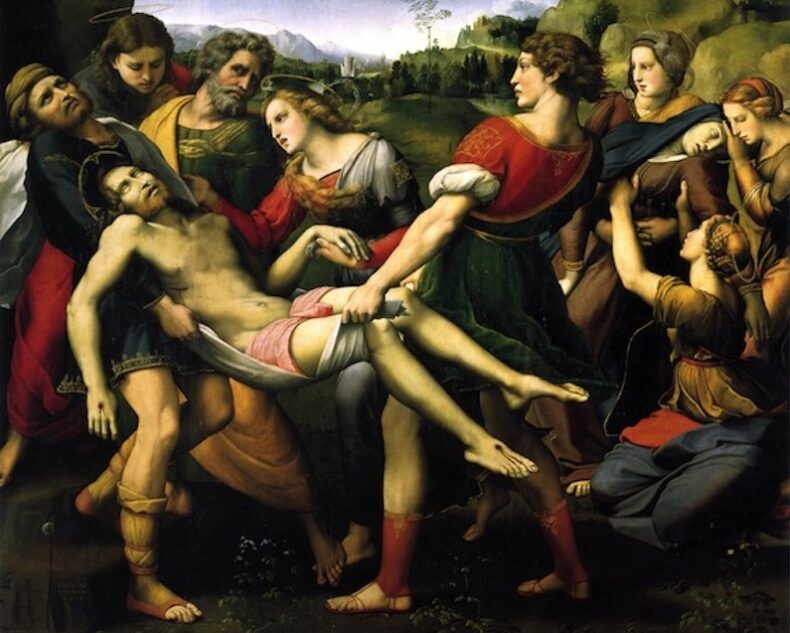‘Fear not, Mary,’ says the Angel Gabriel at the Annunciation, conjuring in the reader’s mind the image of a cowering young woman taken by surprise. It is no wonder that artists have often focused on the Virgin’s shock and anxiety in the moment she discovers she is pregnant. Simone Martini and Lippo Memmi’s version of the scene shows her recoiling from Gabriel’s speech, her arm folded protectively across her chest and stomach. In a drawing attributed to Michelangelo, she twists around to see the angel, her mouth open in surprise. Even the Virgin of Leonardo’s Annunciation tempers her demure acceptance with a cautious raised hand.
The Annunciation (c. 1333), Simone Martini and Lippo Memmi. Gallerie degli Uffizi, Florence

It is rare, then, to see an artist giving Mary a more active role. This also fits with her portrayal in the Gospels to some extent: a woman swept along by providence, with no choice but to accept the sorrows that await her. But Raphael’s drawing of the Annunciation (currently in the exhibition at the National Gallery, on loan from the Nationalmuseum in Sweden), does something different. The image is unusual for several reasons, not least the grand church-like setting, a change from the more common domestic interior. It was probably a modello for an altarpiece, perhaps the one attributed to Mariotto Albertinelli now in the Accademia in Florence. God the Father hovers near the arches, while the Holy Dove in a disc of light penetrates the boundary between heaven and earth. Mary is standing, not seated, while the angel kneels. The final tall and narrow propertions of the altarpiece no doubt encouraged Raphael to give the composition a vertical thrust, but Mary’s upright position also gives her an air of confidence. Like Leonardo’s Virgin she raises her hand, but now in greeting and calm acceptance. It is as if she has been expecting this: she is ready. For once it is the angel who looks surprised.
The Annunciation (c. 1506–07), Raphael. Nationalmuseum, Sweden

In Raphael’s many iterations of the Madonna and Child, the sympathy between mother and son is beautifully conveyed through gestures and facial expressions. In the Tempi Madonna, a gently smiling Mary clasps Jesus to her chest, a gesture borrowed from Donatello’s Verona Madonna. But Raphael’s Virgin also gazes at her child in smiling admiration. The child looks knowingly into the distance, as if contemplating all that is to come, but for now at least Mary is blissfully unaware. In The Madonna of the Pinks, Mary again smiles down at her baby as they exchange handfuls of flowers. The tender care of the mother for her infant is echoed in Raphael’s attentiveness to the reflected white light from the pillow on Jesus’s skin. Where other artists often cast some shadow over Mary’s early interactions with her child – as in The Madonna of the Yarnwinder, attributed to Leonardo, where the Christ Child reaches for the cross – Raphael seems more content to let Mary have her joy while it lasts.
The Tempi Madonna (1508), Raphael. Alte Pinakothek, Munich

Raphael was obsessed with the ways in which bodies communicate with one another. In the School of Athens (reproduced full-size and at eye-level at the National Gallery), interactions are passed like a ball from group to group across the wall, with figures looking at, touching, and disputing with each other, uniting the vast composition into a bustling whole. A similar set of dynamics is explored, at a smaller scale, in the Holy Family with the Palm Tree. Jesus is seated on Mary’s knee but leans towards Joseph, who offers him a handful of flowers. His mother gently restrains him, one hand on the baby’s stomach and the other looped through the scarf wrapped around his body. The many variations in Raphael’s Madonna and Child compositions can be seen as another outpouring of this fascination with human interaction and gesture. But perhaps his images of the archetypal mother and son were also informed by the death of his own mother when he was only eight. She seems to have doted on him: Vasari tells us that, when he was apprenticed to Pietro Perugino at a young age, she cried copiously because she ‘loved him dearly’.
The Deposition (1507), Raphael. Galleria Borghese. Photo: Wikimedia Commons

Of course, no artist can ignore Mary’s sorrows completely. In his radical rethinking of the Deposition (now in the Galleria Borghese), the body of Christ is heaved towards the tomb. In the background Mary swoons, her fainting body mirroring that of her dead son. Her face is prematurely lined with grief; even as she slips into unconsciousness her expression is one of anguish. Seen in the light of the total joy of Raphael’s renderings of her early interactions with her infant, the misery is perfected, the pathos is complete.
‘Raphael’ is at the National Gallery, London, until 31 July.



